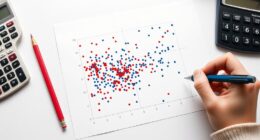To find the mode and range, start by organizing your data. Count how many times each value appears to identify the mode—the most common data point. To find the range, subtract the smallest value from the largest. These measures quickly reveal data patterns and spread, helping you understand the distribution. If you explore further, you’ll discover how to use these tools effectively to interpret and analyze different datasets.
Key Takeaways
- Organize data by listing values or creating a frequency table to identify the most common (mode).
- Count how many times each value appears to determine the mode, especially with multiple or no modes.
- Find the range by subtracting the smallest value from the largest in the dataset.
- Use the mode to reveal the most frequent data point and identify patterns or trends.
- Calculate the range to measure data spread and variability for better understanding of data distribution.

Understanding how to find the mode and range is crucial for analyzing data sets effectively. These tools help you interpret information quickly and make sense of data variation, which is fundamentally in many real-world situations. When you perform frequency analysis, you’re essentially looking for the most common value in your data set—the mode. Identifying the mode allows you to see which data point appears most frequently, giving you insight into patterns or trends. For example, if you’re analyzing test scores and notice a particular score occurs more often than others, that score is your mode. This can reveal common performance levels within a group.
Finding the mode reveals the most common data point in any dataset.
To find the mode, you start by organizing your data, either by listing it out or creating a frequency table. Count how many times each value appears. The value with the highest count is your mode. Keep in mind, some data sets can have more than one mode if multiple values share the highest frequency, making it multimodal. In other cases, there may be no mode at all if all values occur only once. Recognizing these differences helps you better understand the data variation within your set. Data analysis techniques are essential for making informed decisions based on the data you collect.
The range, on the other hand, measures the spread of your data. It’s calculated by subtracting the smallest value from the largest value in the data set. For instance, if your data ranges from 10 to 50, the range is 40. This simple calculation provides a quick snapshot of how spread out your data points are, which is particularly useful when comparing different data sets or assessing variability. A larger range indicates more data variation, meaning your data points are more dispersed, while a smaller range suggests the data are clustered closely together.
Both the mode and range are straightforward yet powerful tools for data analysis. Understanding their roles helps you interpret data more accurately and draw meaningful conclusions. When you analyze data variation, these measures give you a clearer picture of distribution and frequency patterns. They’re especially helpful for summarizing large datasets, identifying outliers, and understanding the overall structure of the data. As you practice finding the mode and range, you’ll develop a sharper eye for recognizing patterns and variations that might otherwise go unnoticed. These skills will serve you well in homework, projects, or any situation where understanding data is important, making your analysis precise and insightful.
Frequently Asked Questions
How Do I Find the Mode in a Data Set With Multiple Modes?
To find the mode in a dataset with multiple modes, identify all values with the highest mode frequency. In multimodal datasets, several numbers share this highest frequency. You then list all these values as the modes. Remember, a dataset can have two or more modes, so don’t assume only one. This helps you understand the distribution better and recognize the most common data points.
What Is the Difference Between Range and Spread?
Range is the difference between the highest and lowest values in your data set, giving you a simple measure of spread. Spread, however, is a broader statistical concept, encompassing various measures like range, variance, and standard deviation to describe how data points are dispersed. Understanding these helps with data interpretation, as they show how much the data varies, revealing the overall distribution and consistency within your data.
Can the Mode Be a Non-Numeric Value?
Like a storyteller choosing words wisely, you can find a non-numeric mode in categorical data, where the most common category takes center stage. Yes, the mode can be a non-numeric value—think colors, brands, or names. When one category appears more often than others, it’s the non-numeric mode that reveals the story behind your data, showing what’s most frequent and meaningful in your dataset.
How Does Outlier Data Affect the Range?
Outlier impact considerably affects data variability by increasing the range. When you have outliers, these unusually high or low values stretch the range, making it larger and less representative of your data set. Outliers can skew your understanding of typical data points, so you should carefully analyze their influence. Removing or addressing outliers helps you get a clearer picture of your data’s true variability and more accurate range.
Is a Smaller Range Always Better?
A smaller range isn’t always better, as it might indicate less data variability, but it can also hide inconsistencies. You should consider data consistency and measurement accuracy. If your data is precise and measurements are accurate, a smaller range can show reliable results. However, if data is inconsistent or measurements are off, a small range might be misleading. Always evaluate the context before assuming a smaller range is ideal.
Conclusion
Just like a treasure hunt, finding the mode and range helps you uncover hidden gems in your data. The mode shows the most common treasure, while the range reveals the distance between the smallest and largest treasures. When you master these tools, your data becomes an adventure rather than a mystery. So keep exploring, and soon you’ll be steering through numbers with confidence, turning math into an exciting journey rather than a confusing maze.










